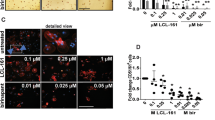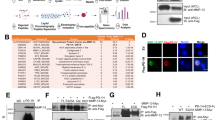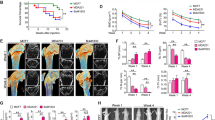Abstract
In multiple myeloma, the overexpression of receptor activator of nuclear factor kappa B (NF-κB) ligand (RANKL) leads to the induction of NF-κB and activator protein-1 (AP-1)-related osteoclast activation and enhanced bone resorption. The purpose of this study was to examine the molecular and functional effects of proteasome inhibition in RANKL-induced osteoclastogenesis. Furthermore, we aimed to compare the outcome of proteasome versus selective NF-κB inhibition using bortezomib (PS-341) and I-κB kinase inhibitor PS-1145. Primary human osteoclasts were derived from CD14+ precursors in presence of RANKL and macrophage colony-stimulating factor (M-CSF). Both bortezomib and PS-1145 inhibited osteoclast differentiation in a dose- and time-dependent manner and furthermore, the bone resorption activity of osteoclasts. The mechanisms of action involved in early osteoclast differentiation were found to be related to the inhibition of p38 mitogen-activated protein kinase pathways, whereas the later phase of differentiation and activation occurred due to inhibition of p38, AP-1 and NF-κB activation. The AP-1 blockade contributed to significant reduction of osteoclastic vascular endothelial growth factor production. In conclusion, our data demonstrate that proteasomal inhibition should be considered as a novel therapeutic option of cancer-induced lytic bone disease.
This is a preview of subscription content, access via your institution
Access options
Subscribe to this journal
Receive 12 print issues and online access
$259.00 per year
only $21.58 per issue
Buy this article
- Purchase on Springer Link
- Instant access to full article PDF
Prices may be subject to local taxes which are calculated during checkout






Similar content being viewed by others
References
Terpos E, Politou M, Rahemtulla A . New insights into the pathophysiology and management of bone disease in multiple myeloma. Br J Haematol 2003; 123: 758–769.
Sezer O, Heider U, Zavrski I, Kuhne CA, Hofbauer LC . RANK ligand and osteoprotegerin in myeloma bone disease. Blood 2003; 101: 2094–2098.
Melton III LJ, Kyle RA, Achenbach SJ, Oberg AL, Rajkumar SV . Fracture risk with multiple myeloma: a population-based study. J Bone Miner Res 2005; 20: 487–493.
Hofbauer LC, Neubauer A, Heufelder AE . Receptor activator of nuclear factor-kappaB ligand and osteoprotegerin: potential implications for the pathogenesis and treatment of malignant bone diseases. Cancer 2001; 92: 460–470.
Abe M, Hiura K, Wilde J, Shioyasono A, Moriyama K, Hashimoto T et al. Osteoclasts enhance myeloma cell growth and survival via cell–cell contact: a vicious cycle between bone destruction and myeloma expansion. Blood 2004; 104: 2484–2491.
Kukita T, Nakao J, Hamada F, Kukita A, Inai T, Kurisu K et al. Recombinant LD78 protein, a member of the small cytokine family, enhances osteoclast differentiation in rat bone marrow culture system. Bone Miner 1992; 19: 215–223.
Nakagawa M, Kaneda T, Arakawa T, Morita S, Sato T, Yomada T et al. Vascular endothelial growth factor (VEGF) directly enhances osteoclastic bone resorption and survival of mature osteoclasts. FEBS Lett 2000; 473: 161–164.
Anderson DM, Maraskovsky E, Billingsley WL, Dougall WC, Tometsko ME, Roux ER et al. A homologue of the TNF receptor and its ligand enhance T-cell growth and dendritic-cell function. Nature 1997; 390: 175–179.
Wong BR, Rho J, Arron J, Robinson E, Orlinick J, Chao M et al. TRANCE is a novel ligand of the tumor necrosis factor receptor family that activates c-Jun N-terminal kinase in T cells. J Biol Chem 1997; 272: 25190–25194.
Yaccoby S, Wezeman MJ, Henderson A, Cottler-Fox M, Yi Q, Barlogie B et al. Cancer and the microenvironment: myeloma-osteoclast interactions as a model. Cancer Res 2004; 64: 2016–2023.
Heider U, Hofbauer LC, Zavrski I, Kaiser M, Jakob C, Sezer O . Novel aspects of osteoclast activation and osteoblast inhibition in myeloma bone disease. Biochem Biophys Res Commun 2005; 338: 687–693.
Giuliani N, Rizzoli V, Roodman GD . Multiple myeloma bone disease: pathophysiology of osteoblast inhibition. Blood 2006; 108: 3992–3996.
Heider U, Langelotz C, Jakob C, Zavrski I, Fleissner C, Eucker J et al. Expression of receptor activator of nuclear factor kappaB ligand on bone marrow plasma cells correlates with osteolytic bone disease in patients with multiple myeloma. Clin Cancer Res 2003; 9: 1436–1440.
Sezer O, Heider U, Jakob C, Zavrski I, Eucker J, Possinger K et al. Immunocytochemistry reveals RANKL expression of myeloma cells. Blood 2002; 99: 4646–4647.
Nakagawa N, Kinosaki M, Yamaguchi K, Shima N, Yasuda H, Yano K et al. RANK is the essential signaling receptor for osteoclast differentiation factor in osteoclastogenesis. Biochem Biophys Res Commun 1998; 253: 395–400.
Simonet WS, Lacey DL, Dunstan CR, Kelley M, Chang MS, Luthy R et al. Osteoprotegerin: a novel secreted protein involved in the regulation of bone density. Cell 1997; 89: 309–319.
Hofbauer LC, Gori F, Riggs BL, Lacey DL, Dunstan CR, Spelsberg TC et al. Stimulation of osteoprotegerin ligand and inhibition of osteoprotegerin production by glucocorticoids in human osteoblastic lineage cells: potential paracrine mechanisms of glucocorticoid-induced osteoporosis. Endocrinology 1999; 140: 4382–4389.
Yasuda H, Shima N, Nakagawa N, Mochizuki SI, Yano K, Fujise N et al. Identity of osteoclastogenesis inhibitory factor (OCIF) and osteoprotegerin (OPG): a mechanism by which OPG/OCIF inhibits osteoclastogenesis in vitro. Endocrinology 1998; 139: 1329–1337.
Lomaga MA, Yeh WC, Sarosi I, Duncan GS, Furlonger C, Ho A et al. TRAF6 deficiency results in osteopetrosis and defective interleukin-1, CD40, and LPS signaling. Genes Dev 1999; 13: 1015–1024.
Boyle WJ, Simonet WS, Lacey DL . Osteoclast differentiation and activation. Nature 2003; 423: 337–342.
Palombella VJ, Rando OJ, Goldberg AL, Maniatis T . The ubiquitin-proteasome pathway is required for processing the NF-kappa B1 precursor protein and the activation of NF-kappa B. Cell 1994; 78: 773–785.
Baeuerle PA, Baltimore D . I kappa B: a specific inhibitor of the NF-kappa B transcription factor. Science 1988; 242: 540–546.
Karin M, Yamamoto Y, Wang QM . The IKK NF-kappa B system: a treasure trove for drug development. Nat Rev Drug Discov 2004; 3: 17–26.
Grigoriadis AE, Wang ZQ, Cecchini MG, Hofstetter W, Felix R, Fleisch HA et al. c-Fos: a key regulator of osteoclast-macrophage lineage determination and bone remodeling. Science 1994; 266: 443–448.
Passegue E, Jochum W, Behrens A, Ricci R, Wagner EF . JunB can substitute for Jun in mouse development and cell proliferation. Nat Genet 2002; 30: 158–166.
Teitelbaum SL . RANKing c-Jun in osteoclast development. J Clin Invest 2004; 114: 463–465.
Li X, Udagawa N, Takami M, Sato N, Kobayashi Y, Takahashi N . p38 Mitogen-activated protein kinase is crucially involved in osteoclast differentiation but not in cytokine production, phagocytosis, or dendritic cell differentiation of bone marrow macrophages. Endocrinology 2003; 144: 4999–5005.
Matsumoto M, Sudo T, Saito T, Osada H, Tsujimoto M . Involvement of p38 mitogen-activated protein kinase signaling pathway in osteoclastogenesis mediated by receptor activator of NF-kappa B ligand (RANKL). J Biol Chem 2000; 275: 31155–31161.
Arrigo AP, Tanaka K, Goldberg AL, Welch WJ . Identity of the 19S ‘prosome’ particle with the large multifunctional protease complex of mammalian cells (the proteasome). Nature 1988; 331: 192–194.
Jakob C, Egerer K, Liebisch P, Turkmen S, Zavrski I, Kuckelkorn U et al. Circulating proteasome levels are an independent prognostic factor for survival in multiple myeloma. Blood 2007; 109: 2100–2105.
Adams J, Palombella VJ, Sausville EA, Johnson J, Destree A, Lazarus DD et al. Proteasome inhibitors: a novel class of potent and effective antitumor agents. Cancer Res 1999; 59: 2615–2622.
Traenckner EB, Wilk S, Baeuerle PA . A proteasome inhibitor prevents activation of NF-kappa B and stabilizes a newly phosphorylated form of I kappa B-alpha that is still bound to NF-kappa B. EMBO J 1994; 13: 5433–5441.
Ciechanover A, DiGiuseppe JA, Bercovich B, Orian A, Richter JD, Schwartz AL et al. Degradation of nuclear oncoproteins by the ubiquitin system in vitro. Proc Natl Acad Sci USA 1991; 88: 139–143.
Stancovski I, Gonen H, Orian A, Schwartz AL, Ciechanover A . Degradation of the proto-oncogene product c-Fos by the ubiquitin proteolytic system in vivo and in vitro: identification and characterization of the conjugating enzymes. Mol Cell Biol 1995; 15: 7106–7116.
Hideshima T, Richardson P, Chauhan D, Palombella VJ, Elliott PJ, Adams J et al. The proteasome inhibitor PS-341 inhibits growth, induces apoptosis, and overcomes drug resistance in human multiple myeloma cells. Cancer Res 2001; 61: 3071–3076.
Yang Y, Ikezoe T, Saito T, Kobayashi M, Koeffler HP, Taguchi H . Proteasome inhibitor PS-341 induces growth arrest and apoptosis of non-small cell lung cancer cells via the JNK/c-Jun/AP-1 signaling. Cancer Sci 2004; 95: 176–180.
Hideshima T, Mitsiades C, Akiyama M, Hayashi T, Chauhan D, Richardson P et al. Molecular mechanisms mediating antimyeloma activity of proteasome inhibitor PS-341. Blood 2003; 101: 1530–1534.
Hideshima T, Chauhan D, Richardson P, Mitsiades C, Mitsiades N, Hayashi T et al. NF-kappa B as a therapeutic target in multiple myeloma. J Biol Chem 2002; 277: 16639–16647.
Terpos E, Heath DJ, Rahemtulla A, Zervas K, Chantry A, Anagnostopoulos A et al. PI. Bortezomib reduces serum dickkopf-1 and receptor activator of nuclear factor-kappaB ligand concentrations and normalises indices of bone remodelling in patients with relapsed multiple myeloma. Br J Haematol 2006; 135: 688–692.
Mundy GR . Metastasis to bone: causes, consequences and therapeutic opportunities. Nat Rev Cancer 2002; 2: 584–593.
Teitelbaum SL . Bone resorption by osteoclasts. Science 2000; 289: 1504–1508.
Suda T, Takahashi N, Udagawa N, Jimi E, Gillespie MT, Martin TJ . Modulation of osteoclast differentiation and function by the new members of the tumor necrosis factor receptor and ligand families. Endocr Rev 1999; 20: 345–357.
Farrugia AN, Atkins GJ, To LB, Pan B, Horvath N, Kostakis P et al. Receptor activator of nuclear factor-kappaB ligand expression by human myeloma cells mediates osteoclast formation in vitro and correlates with bone destruction in vivo. Cancer Res 2003; 63: 5438–5445.
Podar K, Anderson KC . The pathophysiologic role of VEGF in hematologic malignancies: therapeutic implications. Blood 2005; 105: 1383–1395.
Oyajobi BO, Franchin G, Williams PJ, Pulkrabek D, Gupta A, Munoz S et al. Dual effects of macrophage inflammatory protein-1alpha on osteolysis and tumor burden in the murine 5TGM1 model of myeloma bone disease. Blood 2003; 102: 311–319.
Yasuda H, Shima N, Nakagawa N, Yamaguchi K, Kinosaki M, Mochizuki S et al. Osteoclast differentiation factor is a ligand for osteoprotegerin/osteoclastogenesis-inhibitory factor and is identical to TRANCE/RANKL. Proc Natl Acad Sci USA 1998; 95: 3597–3602.
Hsu H, Lacey DL, Dunstan CR, Solovyev I, Colombero A, Timms E et al. Tumor necrosis factor receptor family member RANK mediates osteoclast differentiation and activation induced by osteoprotegerin ligand. Proc Natl Acad Sci USA 1999; 96: 3540–3545.
Zavrski I, Kleeberg L, Kaiser M, Fleissner C, Heider U, Sterz J et al. Proteasome as an emerging therapeutic target in cancer. Curr Pharm Design 2007; 13: 471–485.
Sweeney SE, Hammaker D, Boyle DL, Firestein GS . Regulation of c-Jun phosphorylation by the I kappa B kinase-epsilon complex in fibroblast-like synoviocytes. J Immunol 2005; 174: 6424–6430.
Hideshima T, Hayashi T, Chauhan D, Akiyama M, Richardson P, Anderson K . Biologic sequelae of c-Jun NH(2)-terminal kinase (JNK) activation in multiple myeloma cell lines. Oncogene 2003; 22: 8797–8801.
Krappmann D, Wegener E, Sunami Y, Esen M, Thiel A, Mordmuller B et al. The IkappaB kinase complex and NF-kappaB act as master regulators of lipopolysaccharide-induced gene expression and control subordinate activation of AP-1. Mol Cell Biol 2004; 24: 6488–6500.
Shima DT, Kuroki M, Deutsch U, Ng YS, Adamis AP, D’Amore PA . The mouse gene for vascular endothelial growth factor. Genomic structure, definition of the transcriptional unit, and characterization of transcriptional and post-transcriptional regulatory sequences. J Biol Chem 1996; 271: 3877–3883.
Kumar S, Witzig TE, Timm M, Haug J, Wellik L, Fonseca R et al. Expression of VEGF and its receptors by myeloma cells. Leukemia 2003; 17: 2025–2031.
Acknowledgements
We thank H Kemmer for her excellent technical assistance. Grant support was provided by Deutsche Forschungsgemeinschaft (Klinische Forschergruppe KFO 105).
Author information
Authors and Affiliations
Corresponding author
Rights and permissions
About this article
Cite this article
von Metzler, I., Krebbel, H., Hecht, M. et al. Bortezomib inhibits human osteoclastogenesis. Leukemia 21, 2025–2034 (2007). https://doi.org/10.1038/sj.leu.2404806
Received:
Revised:
Accepted:
Published:
Issue Date:
DOI: https://doi.org/10.1038/sj.leu.2404806
Keywords
This article is cited by
-
ER stress arm XBP1s plays a pivotal role in proteasome inhibition-induced bone formation
Stem Cell Research & Therapy (2020)
-
Rapid degradation of progressive ankylosis protein (ANKH) in craniometaphyseal dysplasia
Scientific Reports (2018)
-
Bortezomib prevents ovariectomy-induced osteoporosis in mice by inhibiting osteoclast differentiation
Journal of Bone and Mineral Metabolism (2018)
-
18F-fluoride-PET for dynamic in vivo monitoring of bone formation in multiple myeloma
EJNMMI Research (2016)
-
Effects of proteasome inhibitors on bone cancer
BoneKEy Reports (2013)



